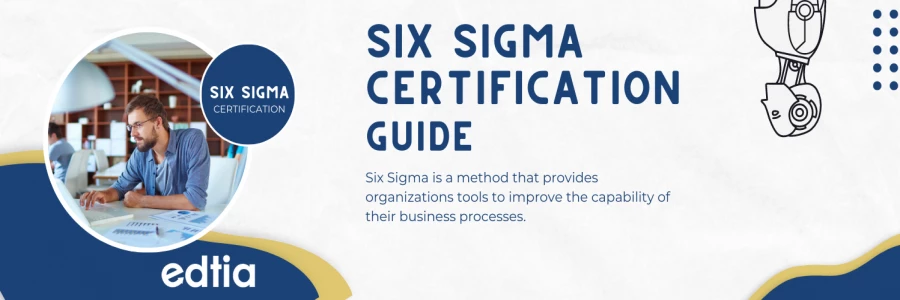Your Shopping Cart

We can help you solve company communication.



Six Sigma is a collection of methods and tools for operation improvement. Developed in 1986, Six Sigma has become a global phenomenon with companies worldwide. Companies and individuals are using six sigma methodologies to improve operational efficiencies. It is a data-driven approach and methodology utilized to eliminate flaws in any process, from manufacturing to transactional, from product to service. Six Sigma has two methods abbreviated as 'DMAIC' and 'DMADV.' DMAIC stands for Define, Measure, Analyze, Improve and Control, and DMADV stands for Define, Measure, Analyze, Define Verify.
A Six Sigma certification is globally acknowledged, which will allow you to get opportunities across the globe. With the certification, your mastery in six Sigma will be officially validated. The six sigma certification is awarded in belt-based levels, and these are white, yellow, green, black, master black, and champion.
Six Sigma is a group of tools and techniques utilized by companies to enhance production processes, eradicate defects, and assure quality. The Six Sigma certification helps validate experts skilled in determining risks, errors, or defects in a business process and terminating them. The certificate can help you become a specialist in process advancement and improve your credibility.
There are various six sigma certification levels: White Belt, Yellow Belt, Green Belt, Black Belt, and Master Black Belt.
The primary six sigma certification level deals with the basic Six Sigma concepts. White belts support management in an organization and engage with regional problem-solving groups that help projects.
Six Sigma Yellow Belt, you know the specifics of Six Sigma and how and where to apply it. You will help project teams with problem-solving tasks.
In Six Sigma Green Belt, you will understand advanced analysis and can settle problems that affect quality. Green belts lead projects and help black belts with data collection and analysis.
Six Sigma Black belts are professionals and agents of change. They deliver training in accession to leading projects.
This is the highest level of Six Sigma accomplishment. You will shape the plan, create crucial metrics, act as a consultant, and train black and green belts.
Six Sigma certification is a great way to enhance your abilities as a leader in your organization, and it assists in renovating your business processes.
A Six Sigma certification can improve its production cost and time. The individual with comprehensive knowledge of Six Sigma tools can help lead progress and improve the turnaround time for every process. when the Six Sigma training is applied, it decreases consumer complaints, errors, and schedule slippages.
A Six Sigma certification points you can decode quality control issues quickly, eradicate sources of error and keep production operating efficiently, which are qualities employers may value.
Candidates must complete projects using the principles to get a six sigma certificate. This experience can help individuals have management experience and earn the ability to make positive changes in an organization.
Certification can support you stand out to employers because of your training in cost reduction, revenue improvement, leadership and quality control. Six Sigma skills can be helpful in many industries.
Getting Six Sigma certified may enable you to ask for a more increased salary in your employment. It could qualify you for new, better-paying roles because it can show you can bear more responsibility and work more efficiently.
Six Sigma offers leaders a chance to explain and rationalize the message. It improves results and can create a sense of companionship, leading to more profitable results.
Using six Sigma is a recognized way to improve an organization. The company needs to have a considerable majority of people trained that understand the methodology. It is easier to drive initiatives and new projects designed to improve processes.
Six Sigma is an established methodology, and it has evolved a culture in big organizations. Everyone in such organizations can adjust to change and contribute to the company's advancement. Leaders need to embrace a constant progress culture to encourage it. By having certified professionals, a continuous improvement in culture will be well adopted.
A Six Sigma certified individual can help their organization and associates use its resources efficiently. The Six Sigma certified employee can identify defects, correct them accordingly, and assure that the methodology is sustainable.
the individual with the Six Sigma certification is accountable for managing cross-domain projects without limitations. The individual who uses this certification is responsible for managing cross-domain projects without restrictions.
Before you start preparing for Six Sigma Certification following points must be taken into account –
Here are the steps that will help you in the process of preparation
Follow these study tips, and you should have the best possible chance of passing your Six Sigma exam.
You'll need to pass the Six Sigma exam to gain your certification. Before taking your exam, make sure you've thoroughly tested your knowledge with online practice tests to hone your exam technique.
There's a wide range of online study guides specifically designed to help you study for the exam. With an emphasis on easy-to-understand and streamlined content, the Six Sigma Study Guide includes a comprehensive review of all exam concepts and practice questions.
Six Sigma courses are designed to give you as much knowledge and skills as possible, enabling you to pass the exam and use the methodology in a natural business environment.
When taking a certification exam, you must learn through your knowledge with a test of the product or technology. In six Sigma, immerse yourself as much as outside of studying for your exam. To do this, you should take advantage of websites, blogs, and other online content.
Every Six Sigma level has various areas of understanding of the tools and techniques associated with the methodology. Six Sigma has two standard methods: DMAIC (Define, Measure, Analyze, Improve, Control) and DMADV (Define, Measure, Analyze, Design, Control). The mastery tests usually include projects and written exams. These tests will confirm that you have the right amount of mastery to complete tasks utilizing the doctrines of Six Sigma. Learn about these tests before preparation.
It will become easier for you to crack Six Sigma certification if the abovementioned points are kept in mind. Candidates can take detailed courses from Edtia to prepare for the Six Sigma certification exam with instructor-led classes and live examples to understand the subjects better.
Share this link via
Or copy link